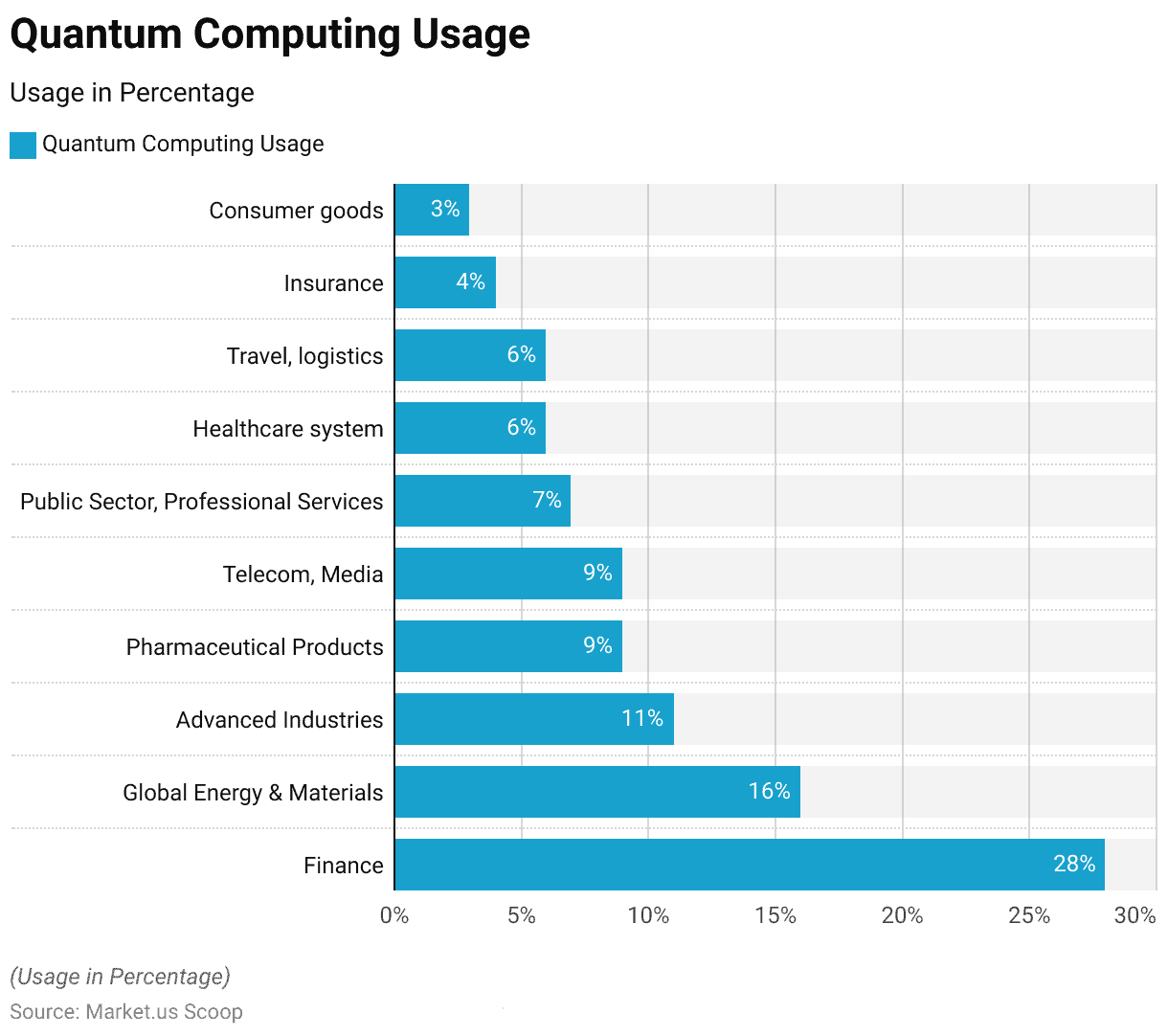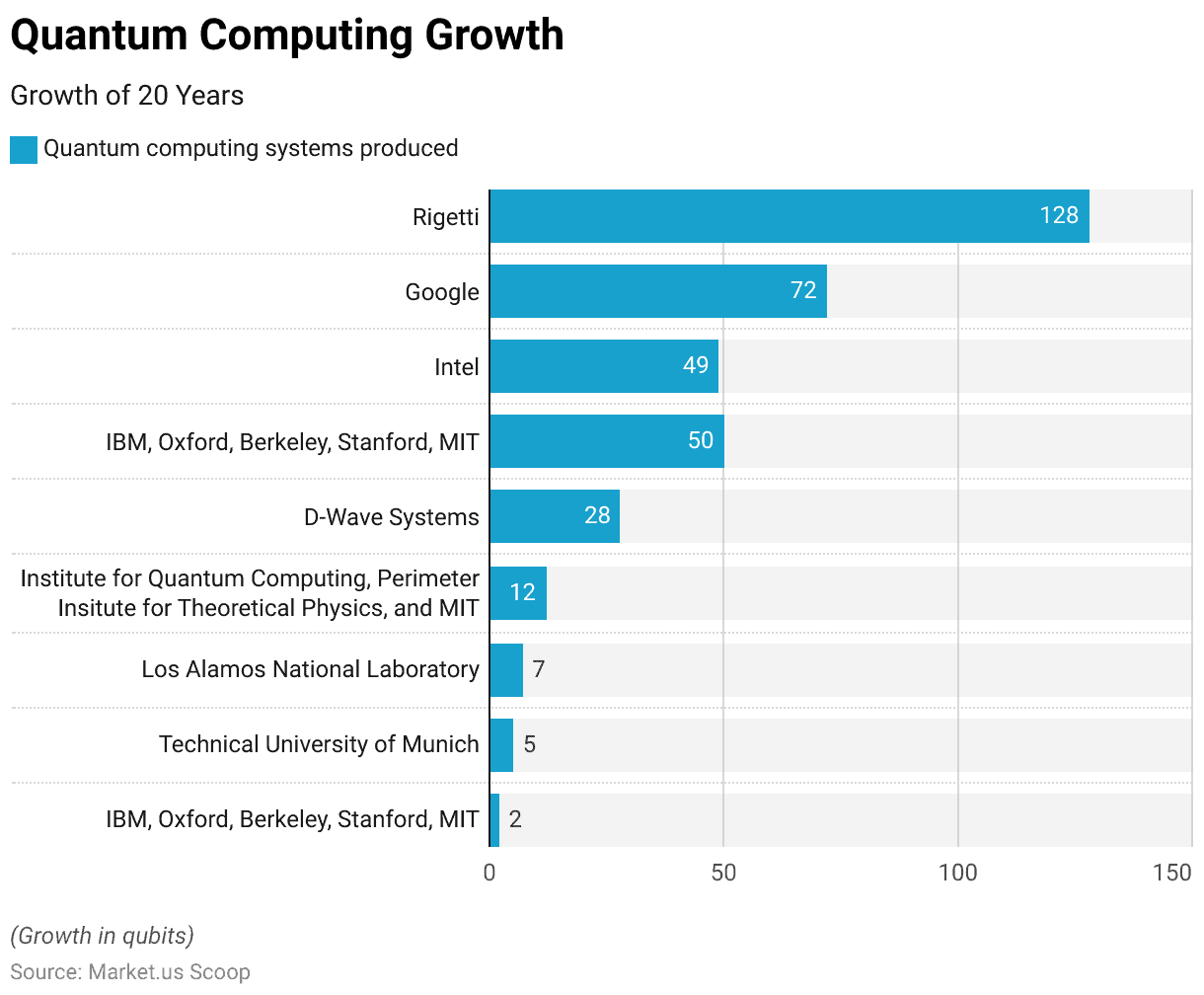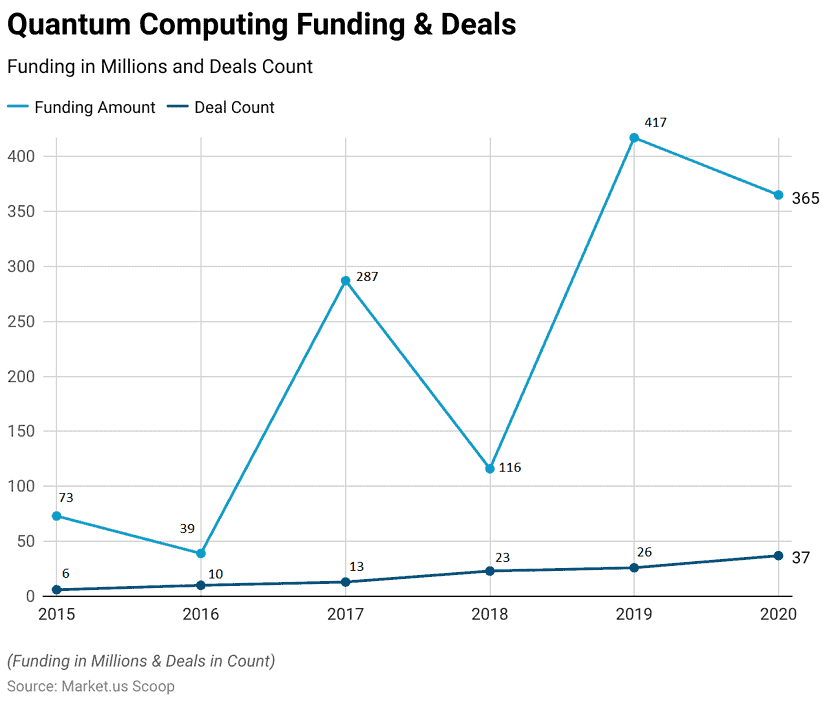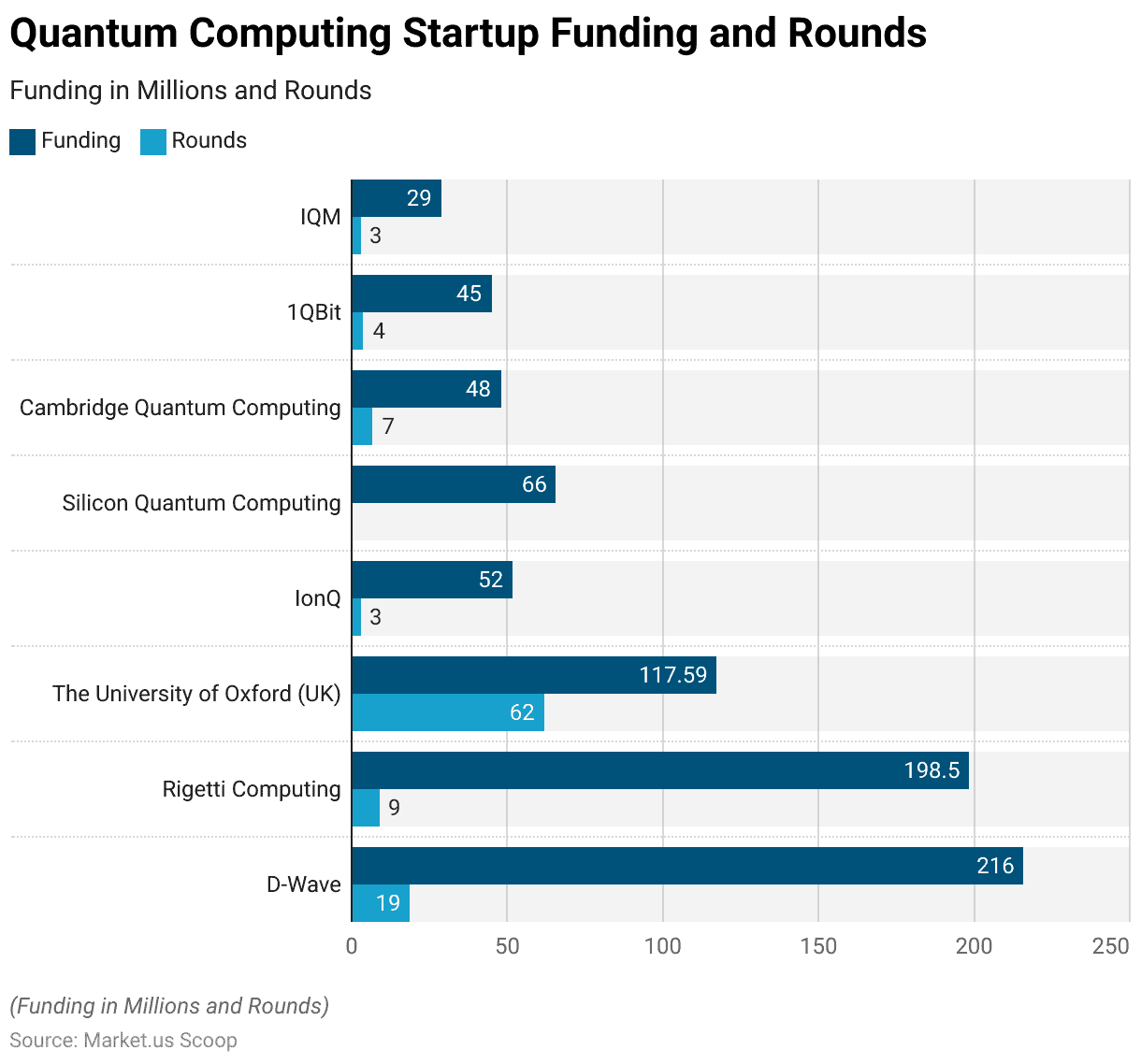Table of Contents
- Introduction
- Editor’s Choice
- Global Quantum Computing Market Size
- Global Quantum Computing Market – Segment Revenue
- Quantum Computing Usage Across Several Sectors
- Quantum Computing Hardware
- 20 Years of Quantum Computing Growth
- Quantum Computing Funding
- Fundings of startups in Quantum Computing
- Quantum Computing Jobs Data
- Methods Used by Organizations To Prepare For Quantum Computing
- Considerations and Challenges in Quantum Computing
Introduction
According to Quantum Computing Statistics, Quantum computing, rooted in the principles of quantum mechanics, employs quantum bits (qubits) that can exist in superposition (representing both 0 and 1 simultaneously) and be entangled, enabling them to perform complex calculations using quantum gates and algorithms.
Notably, quantum computers have the potential to outpace classical counterparts in specific tasks, known as quantum supremacy, with applications spanning cryptography, optimization, drug discovery, and fundamental physics simulations.
However, the field faces significant challenges, including error correction and practical implementation, as it progresses toward unlocking the full scope of its transformative capabilities.
Editor’s Choice
- The D-Wave 2000Q quantum computer operates at a remarkably low temperature of just 0.015 Kelvin.
- 1Qbit stands as the pioneer in dedicated quantum computing.
- The anticipation is that quantum tunneling will significantly reduce power consumption, potentially 100 to 1000 times less.
- Up to now, five companies have ventured into producing quantum chips.
- It’s predicted that the global quantum computing market could reach a valuation of $460.7 billion by the year 2032.
- Looking ahead to 2030, the worldwide count of quantum computers might fall between 2,000 and 5,000 units.
- The Sa 30 qubit quantum computer can perform trillions of operations per second.
- In 2018, the quantum computing industry saw the emergence of 90 fresh job postings for commercial roles.
Global Quantum Computing Market Size
- The quantum computing market is experiencing remarkable growth at a CAGR of 25.4%, with revenues projected to surge in the coming years.
- In 2022, the market was valued at 50.7 billion USD, and this figure is expected to rise to 63.6 billion USD in 2023, demonstrating a steady upward trajectory.
- The subsequent years forecast even more substantial growth, with revenues of 77.6 billion USD in 2024 and 102.5 billion USD in 2025, indicating a significant acceleration.
- As we look further ahead, the quantum computing market is poised to reach 132 billion USD in 2026 and 161.2 billion USD in 2027.
- The growth continues unabated, with projections of 186.4 billion USD in 2028 and 233.7 billion USD in 2029.
- By 2030, the market is anticipated to surpass the 285.4 billion USD mark, and the trend shows no signs of slowing down, with expectations of reaching 357.9 billion USD in 2031 and a substantial 460.7 billion USD in 2032.

Global Quantum Computing Market – Segment Revenue
- The quantum computing market is poised for significant expansion across multiple facets. In 2022, the overall market revenue reached 50.7 billion USD, with hardware contributing 24.1 billion USD, software at 14.4 billion USD, and services accounting for 12.2 billion USD.
- As we progress to 2023, the market is set to grow to 63.6 billion USD, with hardware, software, and services generating 30.3 billion USD, 18.1 billion USD, and 15.3 billion USD, respectively.
- The subsequent years show sustained growth, culminating in a substantial overall market revenue of 460.7 billion USD in 2032, fueled by hardware revenue of 219.3 billion USD, software at 130.8 billion USD, and services generating 110.6 billion USD.
Quantum Computing Usage Across Several Sectors
- Quantum computing is making significant inroads into various sectors, with its usage steadily expanding across industries.
- Quantum computing is at the forefront of finance, with a substantial 28% adoption rate.
- The global energy and materials industry follows closely, with 16% utilization, leveraging quantum capabilities to address complex challenges.
- Advanced industries, including manufacturing and technology, harness computing at 11%.
- Pharmaceuticals and healthcare are also benefiting, with 9% each, promising advancements in drug discovery and healthcare system optimization.
- In telecom, media, and professional services, quantum computing is making a notable impact, with a combined 16% adoption.
- Travel logistics and insurance integrate quantum computing at 4% and 6%, respectively, streamlining operations and risk assessment.

Quantum Computing Hardware
Quantum Memory Statistics
- Trapped ions have shown promise in achieving quantum memory lifetimes lasting over 30 minutes, a significant breakthrough.
- Furthermore, they’ve achieved low error rates, with fewer than 10-3 errors per entanglement swapping operation, a critical factor for efficient quantum repeaters.
- However, the remaining challenge lies in effectively connecting these ions to telecom photons to establish entanglement between repeater stations separated by approximately 30 km.
Quantum Processors Statistics
- Alpine Quantum Technologies introduced the PINE System in June 2021, utilizing trapped ion technology and boasting 24 qubits.
- Atom Computing’s Phoenix, relying on neutral atoms in optical lattices, stood out with perfect fidelity at 100% and was released in August 2021.
- A significant player in the field, Google entered the quantum arena in 2017 with a 20-qubit superconducting system, followed by a planned 49-qubit system in Q4 2017, showcasing exceptional fidelity above 99%.
- Google’s Bristlecone, featuring a 72-qubit superconducting transmon design with high fidelity across multiple qubits, was unveiled on March 5, 2018.
- D-Wave, a prominent manufacturer in annealing quantum processors, has developed a series of QPUs (Quantum Processing Units) known for their quantum annealing capabilities, distinct from digital annealing.
- This lineup began with the D-Wave One, codenamed Rainier, which was introduced on May 11, 2011.
- The D-Wave One employed a superconducting architecture and featured a Chimera layout of 4×4 K4,4 qubits, offering 128 qubits.
- Building on this foundation, D-Wave released the D-Wave Two in 2013, featuring the C8 architecture with an 8×8 K4,4 qubit layout and a significantly expanded qubit count of 512.
20 Years of Quantum Computing Growth
- Quantum computing has seen significant progress, with various organizations and institutions contributing to developing computing systems.
- In 1998, a consortium of IBM, Oxford, Berkeley, Stanford, and MIT introduced an early system with two qubits.
- The year 2000 witnessed advancements, as the Technical University of Munich unveiled a 5-qubit system, while the Los Alamos National Laboratory introduced a 7-qubit system.
- Subsequent developments took place in 2006 when the Institute for Quantum Computing, Perimeter Institute for Theoretical Physics, and MIT jointly launched a 12-qubit system.
- D-Wave Systems made a substantial leap in 2008 with a 28-qubit quantum computer.
- In 2017, the IBM, Oxford, Berkeley, Stanford, and MIT consortium re-entered the scene with a 50-qubit system.
- The following year, in 2018, Intel made its mark with a 49-qubit system, while Google surged ahead with a 72-qubit system.

Quantum Computing Funding
- Over the past six years, computing has seen a fluctuating yet overall upward trend in funding and deal count. 2015, the sector secured $73 million in funding across six deals.
- The following year, in 2016, funding decreased to $39 million but saw an increase in deal count to 10.
- The year 2019 was particularly robust, with a remarkable $417 million in funding distributed among 26 deals.
- In 2020, despite the global challenges posed by the pandemic, quantum computing remained resilient, securing $365 million across 37 deals.

Fundings of startups in Quantum Computing
- Startups and organizations in the computing arena have secured significant funding to advance their research and technologies.
- Leading the pack is D-Wave, which has raised an impressive $216 million across 19 funding rounds.
- Not far behind, Rigetti Computing has garnered substantial support, accumulating $198.5 million through 9 funding rounds.
- The University of Oxford in the UK, a hub for quantum research, has received a notable $117.59 million in grants to bolster its quantum endeavors.
- IonQ, with three funding rounds, has secured $52 million in funding.
- Silicon Quantum Computing has also made strides with a funding infusion of $66 million.
- Cambridge Quantum Computing (CQC) has seen substantial backing, raising $48 million across seven funding rounds.

Quantum Computing Jobs Data
- The US Bureau of Labor Statistics lumps quantum computer research scientists with physicists in collecting data.
- In 2015, the total number of employed physicists stood at 15,650.
- Regarding employment trends, there was a remarkable uptick in job postings related to quantum computing in the commercial sector.
- In July 2018, the number of new job openings reached 188, significantly increasing from the 45 openings recorded in October 2017.
Methods Used by Organizations To Prepare For Quantum Computing
- Organizations are employing diverse strategies to prepare for the adoption of quantum computing.
- On average, more than half of the surveyed organizations are assembling an in-house team.
- Other prevalent preparation methods encompass conducting experiments and constructing proof-of-concept projects, running experiments on quantum hardware or simulators, developing new applications, and collaborating with external vendors.
Considerations and Challenges in Quantum Computing
- When selecting a quantum computing provider, most organizations are primarily concerned with accessibility and compatibility.
- Nearly half of the survey participants, totaling 48%, identified future compatibility as a significant consideration.
- Additional factors considered include credibility, quality, reputation, and the ability to integrate with existing systems seamlessly.
- Security-related issues emerged as the most prevalent challenge for organizations embracing quantum computing in 2022, with 44% of respondents highlighting this concern, marking a 6% increase from the previous year.
Discuss your needs with our analyst
Please share your requirements with more details so our analyst can check if they can solve your problem(s)



